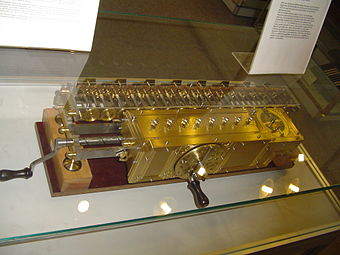Maszyna Leibniza
Stepped reckoner (niem. lebendige Rechenbank, dosł. „żywa ława do obliczeń”) – maszyna licząca zaprojektowana i wykonana przez Gottfrieda Wilhelma Leibniza w 1671.
Maszyna ta była formą kalkulatora mechanicznego opartego na wcześniejszych konstrukcjach (pascalina Blaise’a Pascala i zegar liczący Wilhelma Schickarda). Była zdolna do odejmowania, mnożenia, dzielenia i wyprowadzania pierwiastków kwadratowych.
Linki zewnętrzne
Media użyte na tej stronie
Autor: User:Kolossos, Licencja: CC-BY-SA-3.0
The Staffelwalze, or Stepped Reckoner, a digital calculating machine invented by Gottfried Wilhelm Leibniz around 1672 and built around 1700, on display in the Technische Sammlungen museum in Dresden, Germany. It was the first known calculator that could perform all four arithmetic operations; addition, subtraction, multiplication and division. 67 cm (26 inches) long. The cover plate of the rear section is off to show the wheels of the 16 digit accumulator. Only two machines were made. The single surviving prototype is in the National Library of Lower Saxony (Niedersächsische Landesbibliothek) in Hannover; this is a contemporary replica.

